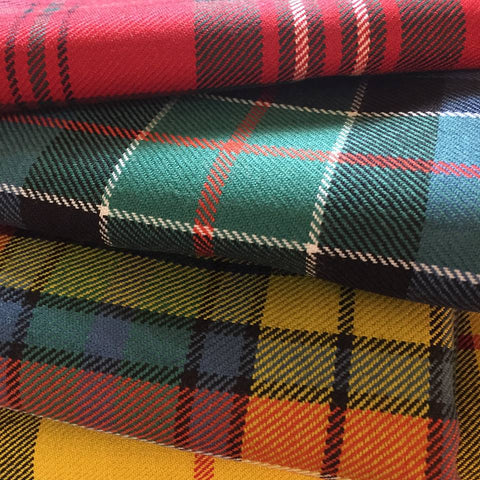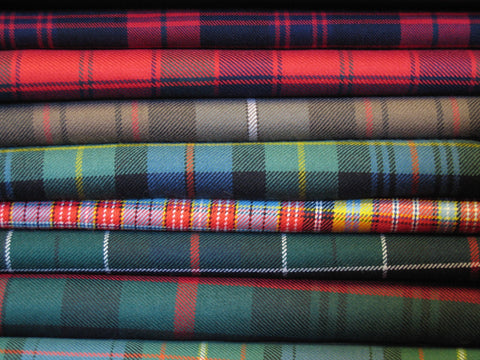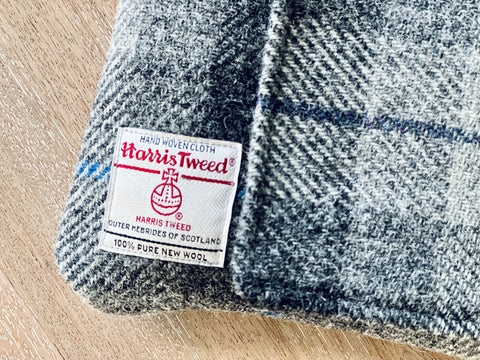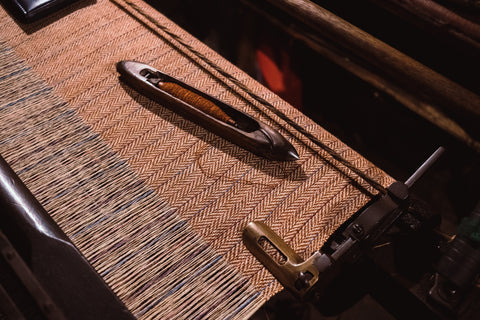
I recall as a child stepping into a fabric shop on The Royal Mile, surrounded by endless rows of tartans and tweeds arranged like a code. “Is there a meaning to all these designs?” I asked. The shopkeeper smiled knowingly. 'Oh, every thread has its tale,' she chuckled. 'These tartans? They're the whispers of clans long past, each colour a chapter of their saga. And the tweeds,' she gestured with a sweep of her arm, 'they're the camouflage of the land, born from the very earth of Scotland.'
I was not just standing in a shop; I was standing in a library of textiles, each fabric a chapter in Scotland's grand narrative. I had discovered a beautiful world of delightful Scottish fabrics and was beginning to learn that Scotland has not one, but two remarkable contributions to the world of textiles: welcome to the world of tweed and tartan!
What are tartan and tweed?
Tweed and tartan are two iconic fabrics with distinctive characteristics that have been popular for centuries. While they are often associated with traditional British clothing, such as kilts and tweed jackets, they are also used in many types of textiles and decor.
So, what is the difference? From a technical perspective, they are very different indeed:
Tweed: is a type of fabric made by weaving multiple coloured yarns together, giving it a textured appearance. The yarns used in tweed are typically made of wool and other natural fibres such as cotton, silk, or linen, in a way such that the fabric both looks good and wears well. This durability is why tweed is often a popular choice in traditional country clothing, or for use in outdoor activities such as hunting or fishing where toughness and weather-resistance is important. The most common colours are earthy tones such as greens, browns, and greys with quite a distinctive flecked appearance. These colours reflect the natural Scottish environment and also pair well with the pursuits in which tweed in used. There is no need for a bright flash of yellow when you are stalking a deer now, is there?

Tartan: unlike tweeds’ use of multiple coloured yarns at once, tartan is made by weaving together horizontal and vertical bands of just one colour at a time to create a distinctive criss-cross design. Tartan fabrics are traditionally made from wool and are associated with kilts and clan tartans. In modern fabrics, tartan can be made from cotton or other synthetic fibres and are used in a huge variety of clothing and upholstery. Tartans generally use brighter and more colourful threads than tweeds, defined by their patterns of multiple colours arranged into distinct, contrasting stripes and checks. Traditionally, each colour pattern, a square or "sett", is associated with different Scottish clans and regions designed to stand out. Tartan is not just a fabric but a symbol of Scottish heritage and identity.

A history of fabrics
Of course, the real beauty in these fabrics lie in their history. The past of both types of fabric are really very rich and deserve a great deal more attention than I can give here! However, by way of quick summary, tartan is the older of the two. Tartans originated as practical "belted plaids" for Highlanders, doubling as kilts for warmth and protection. These early tartans, dyed with local natural resources, were clan identifiers and play a huge role in Scottish history. After the Battle of Culloden in 1746, the government banned tartan to suppress the clan system. This ban lasted for nearly 40 years and is known as "The Dress Act" but the history was not forgotten. Post-Culloden, tartan evolved into a softer fabric, with kilts becoming more ceremonial and tailored.
Nowadays, kilts in Scotland are worn mainly for formal events, though some Scots still don them regularly. Clan patterns are a source of pride, officially recorded in the Scottish Register of Tartans, with some limitations on their use. For example, Queen Victoria and Prince Albert were huge fans of tartan, with Albert designing the Balmoral Tartan sometime around 1853. However, it's so exclusive that it can only be worn with Royal permission! Don’t fret through as many of the popular tartans, like the Royal Stewart tartan, don’t have any restrictions at all, and can be seen on a crazy array of items from scarfs to ties, and from gift wrapping paper to dog collars to use as you see fit.
Tweed, unlike tartan, is closely associated with Scottish estates and modern heritage. It became prominent during the Industrial Revolution and is valued for its durability and protective qualities, crafted from coarse, twisted wool yarns woven into a heavy fabric. Originally designed in patterns and colours to blend into estate landscapes, tweed provided camouflage for outdoor work. Eventually, it gained popularity among the elite and wider public, extending to sportswear, suits, and women's fashion. Read a deeper history of tweeds here.
A notable company to mention here is Harris Tweed, the only fabric in the world protected by its own act of parliament! The Harris Tweed Act of 1993 strictly defines Harris Tweed as "handwoven by the islanders at their homes in the Outer Hebrides, finished in the islands of Harris, Lewis, Uist, Barra, and their several purtenances and made from pure virgin wool dyed and spun in the Outer Hebrides." Harris Tweed is certified with the famous Harris Tweed Orb symbol, a mark of authenticity and quality, which you may well have seen around the world.

Production Methods
It’s worth talking a little bit about how the two fabrics are made, as even if you’re not a haberdasher, the production methods used to make tweed and tartan fabrics are quite different!
Tweed is made using a twill weave, which is a type of weave that produces a diagonal pattern. The twill weave is what gives tweed its unique texture and makes it durable and weather-resistant. Tweed is considered environmentally friendly due to its durability and the natural materials used, making it a sustainable choice in a world of fast fashion. Fun fact: The name 'tweed' is actually the result of a spelling mistake. It was originally called 'tweel', the Scottish word for 'twill', but a London merchant misread the handwriting, thinking the fabric was named after the River Tweed that flows through the Scottish Borders textile area. Whoops! The process of making tweed involves several stages, including carding, the process of separating and straightening the wool fibres, spinning the fibres together to create a yarn and then weaving the yarns together to create the final fabric.
Tartan, on the other hand, is made using a plain weave, which is a simple over-under pattern. The yarns used in tartan are woven together in a specific pattern to create the tartan design. The first step in producing tartan is to dye wool in the desired colours, which is then warped onto a loom and woven together in a specific pattern to create the tartan design. Yarns used are typically flat-dyed, meaning the colour is applied to the yarn before weaving. Sounds simple enough, but perhaps we had best leave it to the experts at Locharron.

Traditions and Modern Day
Today, Tweed and tartan still remain two of Scotland's most enduring and celebrated textiles, each with a narrative as rich and intricate as their patterns.
Tartan, with its bold criss-crosses and vibrant history, has transcended its Highland heritage to become a global icon, synonymous with everything from punk rock to haute couture. Although despite its evolution, tartan remains a ceremonial staple in Scotland, worn with pride at weddings and formal events, and is still seen as a vibrant emblem of Scottish identity. The registry of clan tartans continues to grow, as individuals and families, both in Scotland and beyond, embrace their heritage through these historic patterns.
Tweed has journeyed from the moors to the metropolis, maintaining its reputation as a durable yet stylish fabric. Its earthy tones and subtle patterns, once designed to mirror the Scottish landscape, now grace the collections of luxury designers and urban outfitters alike, symbolizing a blend of rustic charm and sophistication. From country estates to city streets, tweed continues to be a fabric of choice for those seeking comfort, elegance, and a connection to the pastoral heritage of Scotland.
Both fabrics tell a story of a land and its people—a story woven into every thread and dye, a story that endures in kilts and fashion alike. As we embrace these fabrics in contemporary style, we pay homage to their storied past and carry their legacy into the future, one garment at a time.
Do you often wear tweed or tartan? Do you have a tweed jacket or perhaps a tartan scarf in your closet? Or do you wish you had one?
Tell us about your favourite items of Scottish-inspired clothing!

Leave a comment